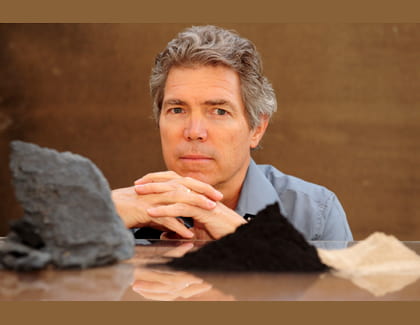Engineering coal power
UCI research addresses the challenges of cleaner, coal-based energy

Coal is readily available and widely used as fuel, but its environmental drawbacks are driving scientists to look for cleaner, more efficient ways to harvest its energy. Engineering professor Derek Dunn-Rankin discusses coal energy and research under way at UC Irvine.
Q: What attracted you to coal research?
A: Small improvements in coal combustion technology can have enormous impact. We burn about 20 pounds of coal, per person, each day. If existing coal power plants can improve efficiency by just 1.5 percent, it is equivalent to doubling the entire amount of currently installed wind power. Or, if we can conserve electrical energy to the same extent, the same benefit accrues. This is one example of how we can significantly reduce pollution and greenhouse gas emission through efficiency improvement and conservation.
Q: Why is coal a good energy source?
A: The primary measure of any fuel’s quality is how much chemical energy can be released from the material relative to the amount of energy it takes to extract and process it. By this gauge, coal is good because it takes relatively little energy to dig it up, clean it, transport it and grind it before burning. On an energy basis, coal fuel is as good as most and better than many. However, this net energy delivery doesn’t always make a fuel attractive. Other factors include storage, safe handling and flexibility, and of course its pollution effects.
From the U.S. energy independence perspective, coal is good because it is abundant locally, relatively easy to obtain and fairly high quality in terms of energy release per mass of fuel. More than 50 percent of electricity used in the U.S. is generated from coal use, and by most estimates we have 250 years of proven coal reserves at the current rate of use. In addition, we know how to mine, transport, grind and burn it.
Q: Coal has been used for energy for a long time. What makes it appealing as a source of energy today?
A: It is not that coal is an appealing source of energy; it is simply an available and heavily used source of energy and therefore an important energy security fuel for the U.S. As such, it will almost certainly continue to be used, since energy is required for all economic activity. I am nearly certain that we – or someone else – will continue to burn coal as long as the return on investment is good. So, it is critical to develop methods for maximizing efficiency while minimizing environmental impact when using this fuel.
Q: What are the biggest challenges to using this type of energy that need to be solved?
A: Emissions from coal combustion contribute significantly to increases in atmospheric carbon dioxide concentrations. Significant efforts are under way to capture and store carbon dioxide from coal-fired boilers, but any dramatic greenhouse gas-limited, coal-fired power plant is at least a decade away. In the meantime, operational adjustments and retrofits to existing boiler designs are important to improve efficiency. New pollution control technologies can reduce emissions, and systems integration and control strategies can lead to performance gains.
Q: What research is your group undertaking to help address some of these issues?
A: We have a number of research activities supported by the Electric Power Research Institute, General Electric/Energy and Environmental Research Corporation and the UC Discovery Program. Plants lose efficiency when preheaters become plugged up or when they are shut down for cleaning. We are studying ways to minimize those losses. We also are looking for a fundamental understanding of processes that will make it possible to design and predict the performance of boilers despite changes in fuel type and composition.
We are developing simulations and experiments to predict accurately residual carbon in ash, because this can mean the difference between ash suitable to be reused for building materials versus unusable ash that must be sent to landfills. We also are developing models for predicting mercury capture in exhaust gas to prevent release of this toxic metal. And, we are investigating combustion technologies to prevent unexpected behavior that can lead to excessive emissions and poor efficiency.

